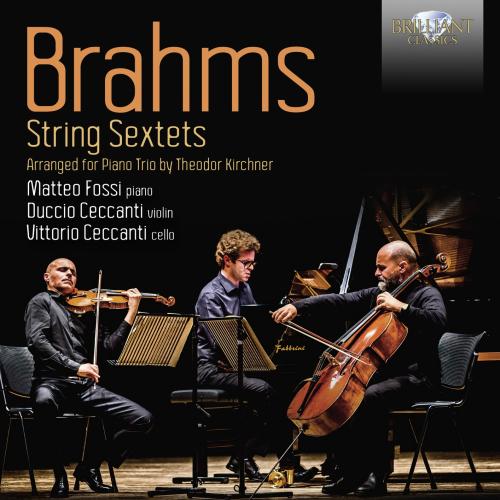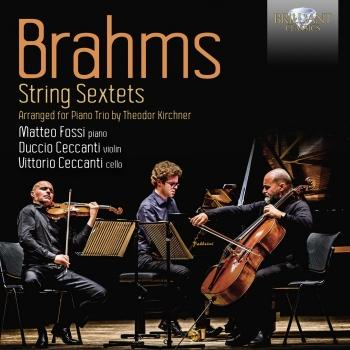
Brahms: String Sextets, Arranged for Piano Trio by Theodor Kirchner Matteo Fossi, Vittorio Ceccanti, Duccio Ceccanti
Album info
Album-Release:
2023
HRA-Release:
31.03.2023
Label: Brilliant Classics
Genre: Classical
Subgenre: Chamber Music
Artist: Matteo Fossi, Vittorio Ceccanti, Duccio Ceccanti
Composer: Johannes Brahms (1833-1897)
Album including Album cover Booklet (PDF)
- Johannes Brahms (1833 - 1897): String Sextet No. 1 in B-Flat Major, Op. 18:
- 1 Brahms: String Sextet No. 1 in B-Flat Major, Op. 18: I. Allegro ma non Troppo 13:49
- 2 Brahms: String Sextet No. 1 in B-Flat Major, Op. 18: II. Andante ma Moderato 09:04
- 3 Brahms: String Sextet No. 1 in B-Flat Major, Op. 18: III. Scherzo 03:12
- 4 Brahms: String Sextet No. 1 in B-Flat Major, Op. 18: IV. Rondo. Poco allegretto e Grazioso 09:58
- String Sextet No. 2 in G Major, Op. 36:
- 5 Brahms: String Sextet No. 2 in G Major, Op. 36: I. Allegro non Troppo 13:26
- 6 Brahms: String Sextet No. 2 in G Major, Op. 36: II. Scherzo 06:59
- 7 Brahms: String Sextet No. 2 in G Major, Op. 36: III. Poco Adagio 08:22
- 8 Brahms: String Sextet No. 2 in G Major, Op. 36: IV. Poco Allegro 08:50
Info for Brahms: String Sextets, Arranged for Piano Trio by Theodor Kirchner
Close to the Schumanns and admired by Mendelssohn and Wagner, Theodor Kirchner (1823–1903) was an accomplished pianist, organist and composer in his own right. His lifelong friendship with Brahms began when the two men met at the spa town of Baden-Baden in 1865. Robert Schumann had already mentioned him in the same breath as Brahms in the influential 1853 article which effectively launched Brahms’s career.
While Kirchner pursued his own, less celebrated career as a composer, he found a reliable subsidiary source of income in making the kind of arrangements through which many listeners made their first encounters with larger-scale works. He seems to have specialised in doing this for Brahms, who regarded him as an outstanding craftsman in this respect. Most of Kirchner’s arrangements were for pianists, either solo or in duet; the notable exceptions being these piano- trio arrangements of the two string sextets which number among Brahms’s earliest successes in the field of chamber music.
The First Sextet, Op.18, dates from five years earlier, premiered on 20 October 1860 in Hanover by an ensemble led by Joseph Joachim and published by Simrock in 1862. Here we find the beardless Brahms in excelsis, the 20-something composer always building up towards but cautiously skirting those perilous peaks of instrumental music which Beethoven conquered and defined in the string quartet and symphony. Falling between the two, the First Sextet in particular behaves like a veiled symphony, much as the First Serenade, Op.15, had flexed symphonic muscles a few months earlier.
Simrock commissioned Kirchner to produce these piano-trio transcriptions in 1883, and they met with the composer’s wholehearted approval; according to Brahms, Kirchner had ‘executed [them] superbly’. Kirchner replied that the new version of the sextets ‘would be a welcome gift for trio players’. The correspondence between the two men testifies not only to the warmth of their friendship but to the faith and trust placed by Brahms in Kirchner’s skills as an arranger. Brahms continued to recommend Kirchner’s services to Simrock, for transcriptions of his own and other composers’ music. He wrote in August 1891: ‘Would you consider replacing Keller with Kirchner for four-hand arrangements?... His elegant, buoyant style of writing would be much finer than the empty stiffness we now have.’
This new recording presents the two famous and beautiful string sextets by Johannes Brahms in the piano trio version by Theodor Kirchner, revised and authorized by Brahms himself.
In the 19th century most the major composers used to transcribe their chamber and symphonic works for various ensembles, usually for piano four hands or two pianos, but also for different ensembles.
Theodor Kirchner (1823-1903) was widely considered to be the finest arranger of his time. Brahms noted that Kirchner could make better arrangements of his works than he could himself. Why did Brahms want an arrangement of his String Sextets? The answer is simple: to make them more widely available. A string sextet, by its very nature requiring six players, was less likely to receive a performance than a work for three. This arrangement, was not only authorized by Brahms himself, it was requested by him. It became actually both more popular and more frequently performed in concert than the original! This arrangement not only entirely retains the character of the original but provides an added dimension.
Played by Duccio Ceccanti (violin), Vittorio Ceccanti (cello) and Matteo Fossi (piano). They already made an excellent recording for Brilliant Classics of the piano quartets by Robert Schumann.
Matteo Fossi, piano
Duccio Ceccanti, violin
Vittorio Ceccanti, cello
Matteo Fossi
born in Florence in October 1978, began studying the piano at the age of eight at the Scuola della Musica in Fiesole with Tiziano Mealli as a mentor, obtaining his degree witht the highest honours in 1999 at the Conservatoire of Ferrara. He later improved himself with Maria Tipo, and then with Pier Narciso Masi. In 2001, he attended, as actual scholar the Maurizio Pollini Seminar at the Accademia Chigiana in Siena.
Really engaged as a concert performer since he was young, he is considered as one of the main chamber music players. He studied along with artists like Piero Farulli, Pavel Vernikov, Alexander Lonquich, the Trio di Milano, Mstislav Rostropovich; he as always played in duet with the violinist Lorenza Borrani (obtaining his degree with Pier Narciso Masi as a mentor at the Accademia di Imola, with the “Best training ever in the last decade” Master, and standing out in the most important and prestigious contests). In 1995 he founded the Quartetto Klimt, one of the most operating Italian chamber music groups, and plays with Marco Gaggini as a piano duet. They recorded the first global complete recording of the music pieces for two pianos by Brahms, Bartòk, Ligeti, Poulenc and Schönberg.
With these lineups, and as a soloist, Fossi performed in all the main Italian opera seasons, and in important international theaters and festivals in Germany, France, Austria, England, Spain, Belgium, Poland, Switzerland, United States of America, Brazil, South Korea. He constantly cooperates with internationally relevant artists such as quali Antony Pay, Mario Ancillotti, Andrea Nannoni, Alexander Ivashkin, Cristiano Rossi, Marco Rogliano, Paolo Carlini, Hansgeorg Schmeiser, Leonardo De Lisi, Massimo Quarta, Othmar Müller, Petra Magoni, Luca Benucci, Moni Ovadia, Milena Vukotic, Mario Caroli, Sonia Bergamasco, Suzanne Linke, Quartetto di Cremona, Quartetto Savinio
He is extremely engaged in the recording activity for the Decca, Universal, Brilliant, Naxos, Nimbus, Tactus, Amadeus, Unicef, Fenice Diffusione Musicale labels; in 2004 his first soloist cd was released, dedicated to Brahms, Hortus editions.
Interested also in music spreading and organization, he is artistic director of the “Nuovi Eventi Musicali” Association, born in 2001, whereby he brought in Florence some of the most important worldwide music personalities: Rostropovich, Kagel, Penderecki, Sofia Gubaidulina, Kronos Quartet. He is the President of the Chamber Music Orchestra “I Nostri Tempi”, and he was artistic director of the classical area of the Estate Fiesolana, the most ancient outdoor festival in Italy.
Matteo Fossi teaches leading piano at the Istituto Superiore di Studi Musicali “Rinaldo Franci”, chamber music at the Scuola di Musica of Fiesole and he is regurarly invited to hold international masterclasses in Italy and abroad.
Duccio Ceccanti
graduated with honours from the Conservatorio Luigi Cherubini in Florence and continued his studies with Salvatore Accardo, Felix Andrievsky, Stefan Gheorghiu and Boris Belkin.
At a young age he was invited to perform at venues around the world, including Carnegie Hall and Columbia University in New York, Teatro Coliseo in Buenos Aires, Auditorium RSI in Lugano, Teatro di San Carlo in Naples and prestigious festivals including Maggio Musicale Fiorentino and the Biennale di Venezia. He has given premiere performances of works, some dedicated to him, by eminent composers such as Luciano Berio, Krzysztof Penderecki, Luca Francesconi, Peter Maxwell Davies, Luis de Pablo and Henri Pousseur. He performs with Quartetto Klimt and Contempoartensemble, and has made recordings for Brilliant Classics, Naxos, Stradivarius and Amadeus Magazine.
He teaches violin at the Conservatorio Giacomo Puccini, La Spezia and the Scuola di Musica di Fiesole. In 2017 the Accademia Internazionale Medicea awarded him the Laurentian Medal for artistic merit at the 30th edition of the Lorenzo il Magnifico Prize, held at Firenze, Salone dei Cinquecento of Palazzo Vecchio.
Vittorio Ceccanti
began playing the cello aged five, studying with Mischa Maisky and David Geringas and graduating with honours as a pupil of Natalia Gutman from the Hochschule für Musik in Stuttgart.
He made his debut as a soloist aged 17 performing Lalo’s Cello Concerto conducted by Pinchas Steinberg at the Musikvereinssaal in Vienna, and Saint-Saëns’ Cello Concerto at the Teatro di San Carlo in Naples, which was televised by RAI TV. Since then, he has been invited to perform regularly as a solo artist in Europe, the Americas and Asia.
He has made many recordings including the Beethoven cello sonatas for EMI Classics, Chopin’s complete works for cello and piano and Sardelli’s Cello Concerto with Modo Antiquo conducted by the composer for Brilliant Classics, Mendelssohn and Fauré’s complete works for cello and piano with the pianist Bruno Canino for Amadeus Magazine, plus Peter Maxwell Davies’ complete works for cello including his Cello Concerto for Naxos.
Booklet for Brahms: String Sextets, Arranged for Piano Trio by Theodor Kirchner











